Planning an adventure to Morocco? You’re in for a treat! This North African gem offers a captivating blend of ancient culture, stunning landscapes, and vibrant city life. Having recently explored Morocco myself, I’ve put together this essential travel guide to equip you with everything you need to know for your Moroccan escapade.
From navigating transportation and understanding cultural nuances to discovering the must-see attractions, this guide is your one-stop resource for Travelling Through Morocco. Get ready to be inspired and confident in planning your own incredible journey through this magical country. Let’s dive into your ultimate Morocco travel guide!
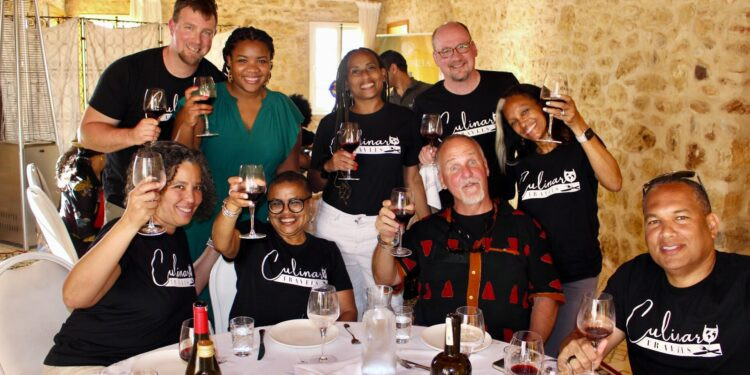 Wine tasting at Volubilia-Domaine de la Zouina
Wine tasting at Volubilia-Domaine de la Zouina
Visa Requirements for Morocco
Good news for many travellers! Citizens from the United States, Canada, the United Kingdom, EU countries, Australia, New Zealand, and numerous other nations do not require a visa for tourist visits to Morocco lasting up to 90 days.
Furthermore, Morocco currently has no COVID-19 related travel restrictions or requirements, making your journey even smoother.
Discovering Morocco’s Location
Morocco is strategically located in the northwest corner of Africa, just south of Spain, across the Strait of Gibraltar. This unique geographical position places it at a fascinating crossroads – African soil, a stone’s throw from Europe, and deeply rooted in Arab and Berber cultural traditions.
Your Journey to Morocco: How to Get There
No travel guide for travelling through Morocco would be complete without addressing how to arrive! The primary international gateway is Casablanca Airport (CMN), likely the destination for your flight. Marrakech Menara Airport (RAK) is another significant option. Both airports are well-served by major airlines such as Delta, American Airlines, Emirates, British Airways, and Air Canada.
However, there are some airline specifics to consider. For instance, United Airlines operates flights to Casablanca Airport but not Marrakech Menara Airport. Depending on your planned itinerary for travelling through Morocco, you might find it convenient to fly into one airport and depart from the other. Many travellers, including myself, opted for this approach, flying into Casablanca and departing from Marrakech.
Alternatively, you can reach Morocco by ferry from Spain. Ferry durations vary from a swift 1 hour and 30 minutes to a longer 36-hour voyage, depending on the route. Several ports offer departures and arrivals. The quickest ferry crossings from Spain are from Algeciras and Tarifa ports to Tangier, taking approximately 60-90 minutes. The Barcelona to Tangier route spans about 28 to 36 hours. Bringing your car to Morocco via ferry is also possible, though it necessitates additional planning.
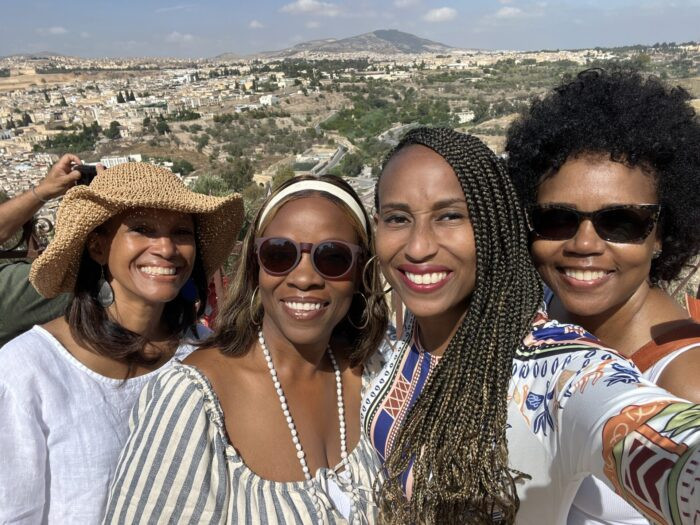 Panoramic views of Fes, Morocco, showcasing the city's ancient architecture and vibrant atmosphere
Panoramic views of Fes, Morocco, showcasing the city's ancient architecture and vibrant atmosphere
Navigating Transportation Within Morocco
Once you arrive, getting around Morocco is relatively straightforward with various options available:
Rail Travel
Morocco boasts a commendable railway network – comfortable, efficient, and generally punctual. Trains effectively connect major northern cities, providing an affordable and convenient mode of transport for travelling through Morocco.
Bus Services
Numerous public and private bus companies operate extensive routes across the country. However, buses tend to be slower and can sometimes be crowded. For shorter distances, the taxi options are often preferable.
Taxi Options: Petit and Grand Taxis
Morocco offers two primary types of taxis: petit taxis and grand taxis.
Petit taxis are smaller vehicles accommodating up to three passengers. Readily available, they are the most common way to navigate within cities.
Grand taxis are larger, typically seating up to six passengers. While usable within cities, they are primarily intended for intercity travel.
While Uber is not available in Morocco, “Careem” is a ride-hailing app operating in major cities. In Marrakech, “Heetch” and “Roby” are local taxi apps. For a more personalized experience, especially when staying in a Riad or hotel, concierge or front desk staff can arrange private car services with drivers.
Domestic Flights
For long-distance travel between major cities, consider domestic flights. Royal Air Maroc and Air Arabia Maroc are the two main domestic airlines. This can save significant travel time, especially when traversing the diverse landscapes of Morocco.
Ideal Timing for Your Moroccan Adventure
The most favourable periods for travelling through Morocco are spring and autumn: March to May (mindful of Ramadan) and September to November. During these shoulder seasons, the weather is pleasantly mild, avoiding both scorching summer heat and chilly winter temperatures, and you’ll also sidestep the peak summer tourist crowds. My visit in early June offered delightful weather and fewer tourists.
Planning Around Ramadan
Islam is the state religion of Morocco. While most religious holidays won’t greatly affect your travel plans, Ramadan is an important exception to consider when travelling through Morocco.
Ramadan, typically lasting 30 days in March/April or April/May, is a period when Muslims fast from dawn to sunset daily. Consequently, many local restaurants and cafes may be closed during daytime hours, some for the entire month. While non-Muslims are not expected to fast, these closures can impact your daytime dining options.
However, experiencing Morocco during Ramadan offers a unique cultural perspective. After sunset, cities come alive with vibrant celebrations and evening meals, providing a special atmosphere.
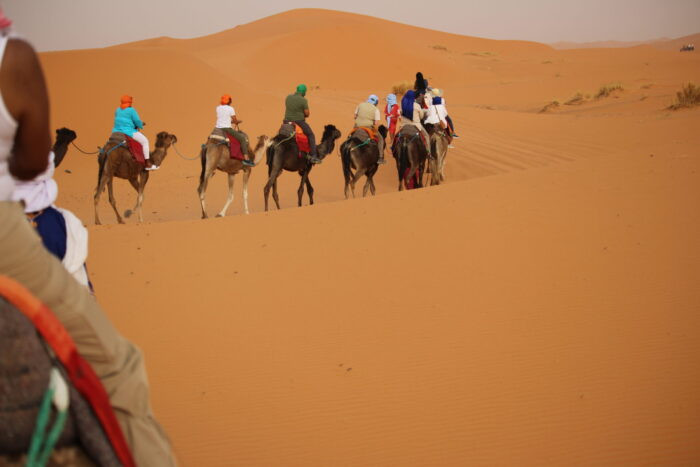 Experience camel rides at sunset in the Sahara Desert, a quintessential Moroccan adventure
Experience camel rides at sunset in the Sahara Desert, a quintessential Moroccan adventure
Moroccan Seasons and Climate
Northern Moroccan cities like Casablanca and Tangier enjoy a Mediterranean climate. Even in the humid summer, sea breezes offer cooling relief. Casablanca’s average temperatures range from 73°F (23°C) in summer to 55°F (13°C) in winter.
Inland cities such as Fes and Marrakech in central and southern Morocco experience significantly hotter summers, often becoming uncomfortably so. Marrakech can reach triple-digit temperatures in summer, with average summer temperatures in the 90s. Winter averages around 54°F (12°C).
Rainfall is most prevalent from November to March, particularly in coastal regions. Factor this into your planning when travelling through Morocco, especially if you intend to explore coastal areas during these months.
Language Essentials in Morocco
Morocco has two official languages: Modern Standard Arabic and Standard Moroccan Berber.
However, Moroccan Arabic (a dialect of Modern Standard Arabic) and various Berber dialects are the most commonly spoken languages in daily life.
Due to historical French influence, French is also widely spoken and understood throughout Morocco.
English Language Accessibility
English is not widely spoken across Morocco. However, most individuals working in the tourism sector possess basic English communication skills. Learning a few basic French or Arabic phrases can greatly enhance your interactions and travel experience while travelling through Morocco.
Managing Money in Morocco
The Moroccan Dirham (MAD) is the local currency. Cash is king in many Moroccan establishments, especially in souks and smaller shops. It’s advisable to withdraw Dirhams from ATMs upon arrival for better exchange rates. Airport currency exchange is also an option. Major restaurants and larger shops (excluding smaller souk vendors) generally accept credit cards, though American Express may not be as widely accepted. Having cash readily available is essential for tipping and souk shopping during your travels through Morocco.
Understanding Moroccan Dress Code
Modesty in dress is customary in Morocco, reflecting Muslim cultural norms, particularly for women.
As a visitor, opting for modest attire is recommended: tops covering chest and shoulders, and lightweight pants or knee-length shorts. Long dresses and skirts (below the knee) are also suitable. As a general guideline, shoulders, chest, and knees should be covered. When visiting mosques, ensure both shoulders and chest are covered. Head coverings are not mandatory but carrying a scarf is advisable, just in case. Dress codes tend to be more relaxed in Marrakech. For mosque entry for both men and women, shoes must be removed. Bringing a bag for shoe storage is practical.
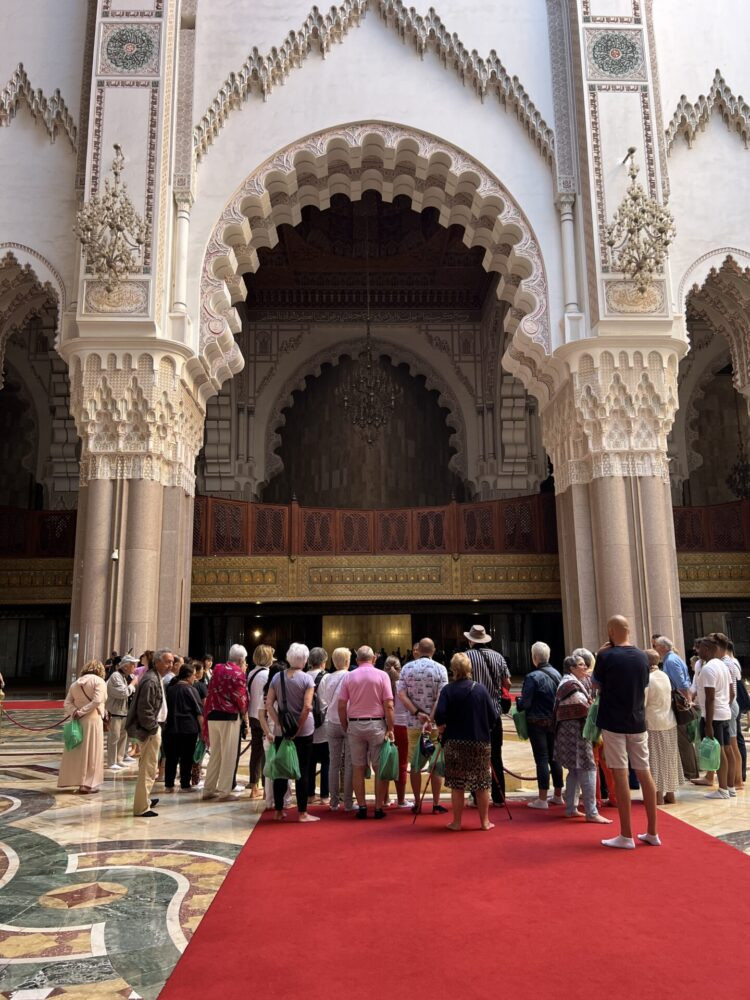 Inside the Hassan II Mosque in Casablanca, showcasing the intricate details and grandeur of Moroccan religious architecture
Inside the Hassan II Mosque in Casablanca, showcasing the intricate details and grandeur of Moroccan religious architecture
Accommodation Choices in Morocco
Riads are a quintessential Moroccan accommodation experience, particularly in cities. Modern Riads are hotels or guesthouses, often restored palaces or mansions, featuring shared courtyards or gardens and private rooms. Their architecture is often magnificent. Many Riads are located within Medinas (old city centres), offering convenient access to dining and shopping. Thoroughly check reviews when selecting a Riad. For a quieter stay, consider hotels and resorts located outside the Medina.
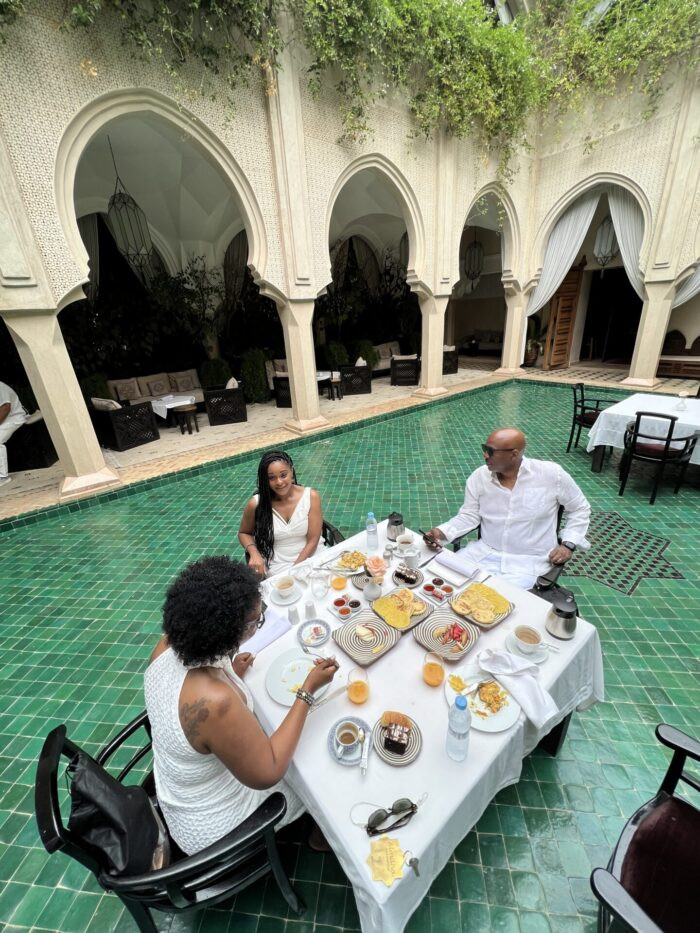 Inside a traditional Moroccan Riad, showcasing the beautiful courtyard and intricate design
Inside a traditional Moroccan Riad, showcasing the beautiful courtyard and intricate design
Must-Visit Destinations and Activities in Morocco
Wondering where to go and what to do while travelling through Morocco? Each Moroccan city presents a unique allure, from bustling Medinas and vibrant souks to magnificent mosques and serene gardens. Here are my top recommendations:
Casablanca
While not Morocco’s official capital, Casablanca is a dynamic and modern city that feels like the country’s beating heart. It seamlessly blends modernity with historical charm.
Hassan II Mosque: A monumental mosque, one of the world’s largest and one of the few in Morocco open to non-Muslims. A visit is a must-do when travelling through Morocco.
Mohamed V Square: A lively central square where locals congregate, offering a taste of authentic Casablanca life. Explore the square and browse local vendor offerings.
Museum of Moroccan Judaism: A unique museum dedicated to the 2,000-year history of the Jewish community in Morocco, providing insights into a significant facet of Moroccan history.
Fes
In contrast to Casablanca, Fes is a city deeply rooted in ancient history and tradition. Its labyrinthine streets guide you through a bustling Medina and past majestic mosques.
Royal Palace: While interior access is restricted, admire and photograph the impressive seven front gates of this palace, built in the 1960s. The craftsmanship is truly remarkable.
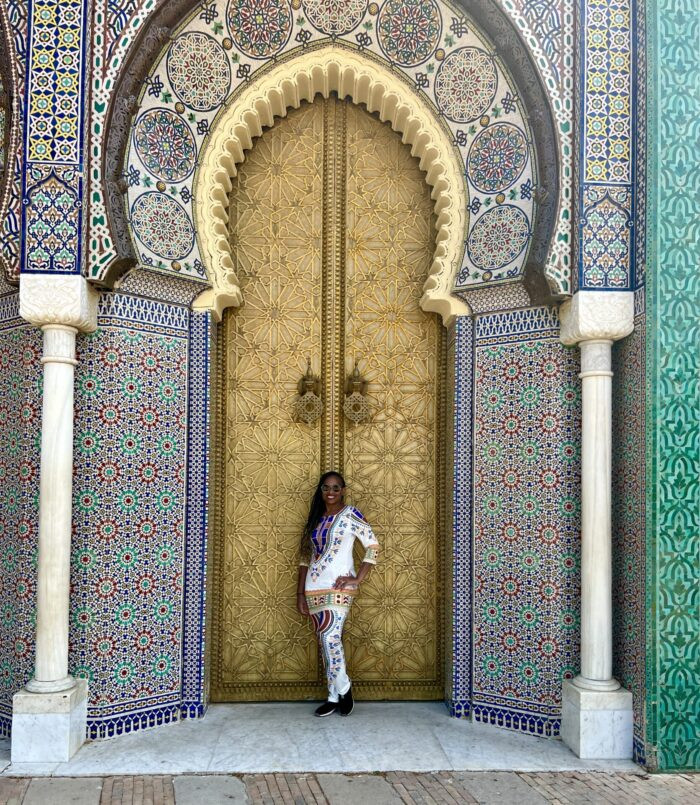 The ornate doors of the Royal Palace in Fes, showcasing intricate Moroccan design
The ornate doors of the Royal Palace in Fes, showcasing intricate Moroccan design
Jewish Cemetery: Distinctive white tombs dotting a hillside mark this extensive Jewish cemetery, established in 1883. Restored in 2019, it contains the graves of notable figures venerated by both Muslims and Jews.
Madrasa Bou Inania: A 14th-century Muslim learning institution showcasing stunning architecture, adorned with green tiles, marble columns, and exceptional Moroccan craftsmanship.
Borj Nord: A late 16th-century fort now housing the Museum of Arms, displaying thousands of historical artefacts, including a cannon used in a 16th-century war.
Medina of Fes: One of Morocco’s largest and most intricate Medinas (historic districts encompassing residences, shops, and markets). For an authentic Moroccan experience, exploring the Fes Medina is essential. However, even seasoned market-goers may find it overwhelming, so caution and vigilance are advised. It’s easy to get lost in the winding alleys.
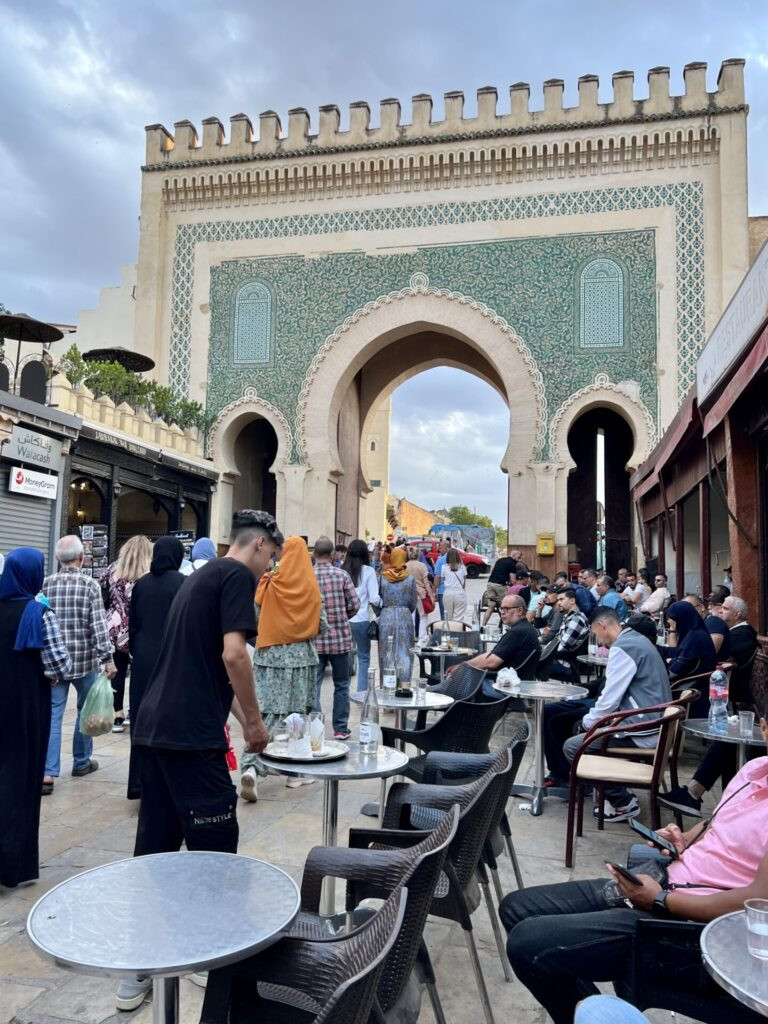 A bustling street scene within the Medina of Fes, showcasing the vibrant daily life and architecture
A bustling street scene within the Medina of Fes, showcasing the vibrant daily life and architecture
Chouara Tanneries: Witness the traditional dyeing of animal hides at the Chouara Tanneries. While entry to the tanning pits is restricted, viewing terraces offer a vantage point to observe the process. Be prepared for a strong odour – mint leaves are often offered to help alleviate any potential nausea. The surrounding shops offer an incredible array of leather goods, and haggling is part of the culture. Tipping may be expected from tannery workers.
Merzouga
Merzouga, a peaceful town on the edge of the Sahara Desert, serves as the gateway to Erg Chebbi, a vast expanse of sand dunes. Activities include camel treks, jeep tours, and ATV adventures across the dunes.
Experience glamping in the Merzouga Desert, offering unparalleled stargazing opportunities away from light pollution. While cloudy skies obscured our full stargazing experience, we still enjoyed glimpses of stars and a beautiful sunset. Sandboarding is another popular activity. Our glamping experience included live music and drumming around a campfire, accompanied by wine and dancing – an unforgettable evening. The following morning, we embraced the desert setting with a colourful photoshoot.
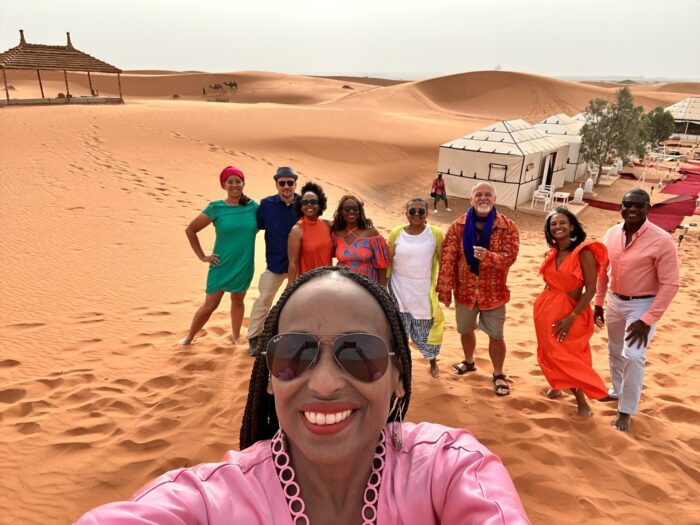 A glamping site in the Merzouga Desert, offering luxurious accommodation amidst the sand dunes
A glamping site in the Merzouga Desert, offering luxurious accommodation amidst the sand dunes
Embark on a hike to the highest dune in Erg Chebbi. Reaching the summit takes about an hour and is moderately challenging. Avoid midday heat and bring ample water.
Observe flamingos at Dayet Srji, a salt lake west of Merzouga. The lake attracts migratory birds like flamingos throughout the year, being full in winter and drying out in summer.
Dades Valley/Dades Gorge
Nestled within the dramatic Atlas Mountains, the Dades Valley presents stunning scenery. Boumalne Dades is the main town, perched on a plateau surrounded by towering cliffs.
Auberge Chez Pierre Hotel in Boumalne Dades is a charming hotel offering stately interiors and modern comforts at an affordable price point, including its restaurant, where a 5-course meal is available for approximately 22 euros.
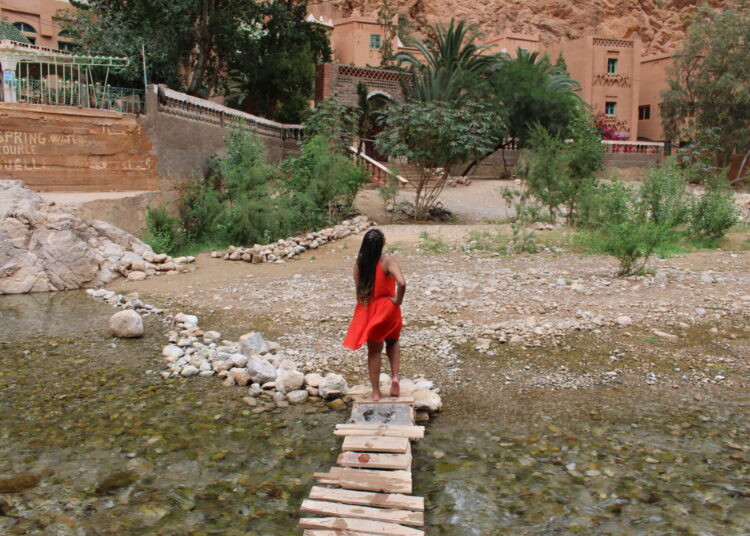 Scenic view of Dades Gorge, showcasing the dramatic rock formations and landscape
Scenic view of Dades Gorge, showcasing the dramatic rock formations and landscape
Explore the diverse landscapes of Dades Valley, from imposing cliffs to lush gardens. The region offers a surprisingly varied environment and welcoming Berber hospitality.
Visit Rose Valley and the nearby village of Kelaat M’Gouna to appreciate the beauty of Morocco’s desert regions and immerse yourself in Berber culture.
Marrakech
Marrakech, a popular tourist destination, manages to retain an authentic feel. It effortlessly blends tradition and modernity and is considered the primary city of central Morocco.
Koutoubia Mosque, Marrakech’s largest mosque, also known as “Mosque of the Booksellers.” Originally built in 1147 and rebuilt between 1158-1195, its 77-meter minaret is a prominent Marrakech landmark.
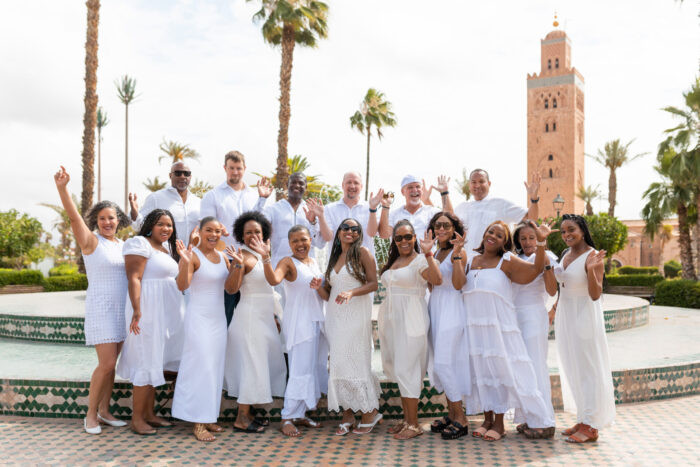 Group photo in Marrakech with the iconic Koutoubia Mosque minaret in the background
Group photo in Marrakech with the iconic Koutoubia Mosque minaret in the background
Jemaa el-Fnaa square transforms into a vibrant spectacle as day turns to evening, filled with street performers, musicians, and enticing food stalls.
Bahia Palace, a 19th-century architectural masterpiece, features opulent interiors, tranquil courtyards, verdant gardens, and ornate fountains. Its beauty is captivating. While often crowded, it offers stunning photo opportunities.
Jardin Majorelle, a lush botanical garden, showcases bamboo groves, dwarf palm trees, agave plants, and more. The Berber Museum is also located within the gardens. Formerly the residence of Yves Saint Laurent, the gardens are renowned for their striking “Majorelle Blue” colour. A truly unmissable Marrakech attraction.
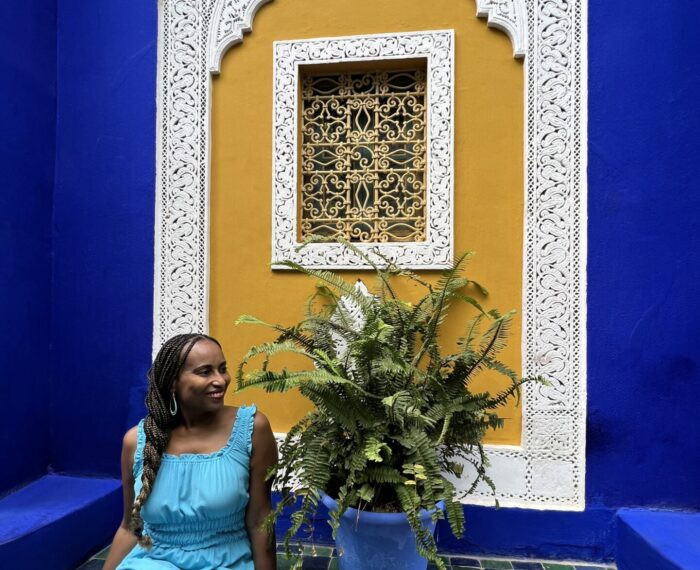 Nadeen posing in the vibrant Jardin Majorelle in Marrakech, surrounded by lush greenery and blue accents
Nadeen posing in the vibrant Jardin Majorelle in Marrakech, surrounded by lush greenery and blue accents
The YSL Museum is conveniently located nearby, exhibiting Yves Saint Laurent’s creations, including garments, accessories, sketches, photographs, and a gift shop. A charming café with outdoor seating and a pool is also part of the complex.
Hotel La Maison Arabe: Although not where I stayed, this hotel is highly recommended for its Tagine cooking class and Hammam spa treatments, both of which were thoroughly enjoyed by our group members.
Jnane Tamsna: A Black, woman-owned hotel located about 15 minutes from the Marrakech Medina. We enjoyed sunset cocktails and appetizers on the rooftop, followed by dinner on the hotel grounds, and had the pleasure of meeting the lovely owner.
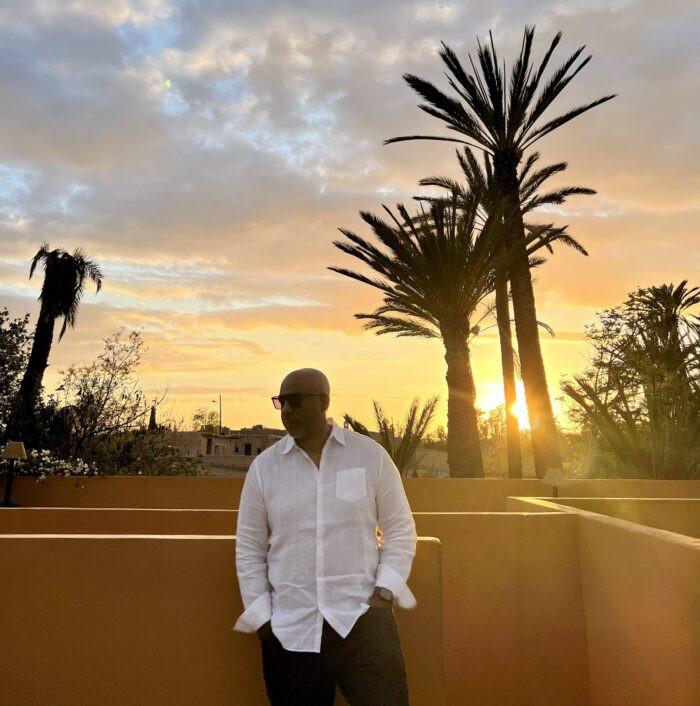 Enjoying the sunset from the rooftop of Jnane Tamsna hotel in Marrakech, with panoramic views
Enjoying the sunset from the rooftop of Jnane Tamsna hotel in Marrakech, with panoramic views
Itinerary Suggestion: Our Moroccan journey covered significant ground: Casablanca (1 night), Fes (2 nights), Sahara/Merzouga glamping (1 night), Dades/Atlas Mountains (1 night), and Marrakech (3 nights), totalling 8 nights with considerable driving. This itinerary provides a comprehensive view of Morocco’s diversity. For shorter trips, focusing on one or two cities is advisable. Marrakech was a personal highlight, embodying my expectations of Morocco’s atmosphere and aesthetics.
Savouring Moroccan Cuisine
Moroccan food deserves its own dedicated exploration! Being a Culinary Travels food tour, our itinerary included a Fes food walking tour, Marrakech food stall visits, and a Marrakech cooking class. You can see highlights on my Instagram HIGHLIGHT REEL of Morocco.
Moroccan cuisine is fragrant and spice-rich, featuring turmeric, saffron, and cumin prominently. Some dishes had curry-like notes. We often added salt to dishes, aligning with American palates. Bread is a staple, served in various forms at every meal: pancakes, crepes, flatbreads, puffy breads, pastries, and fruits for dessert.
Must-try traditional Moroccan foods and beverages:
Couscous: Morocco’s national dish. Even if you’ve tried couscous before, experiencing it in Morocco is a must. Traditionally served with meat and/or vegetable stew.
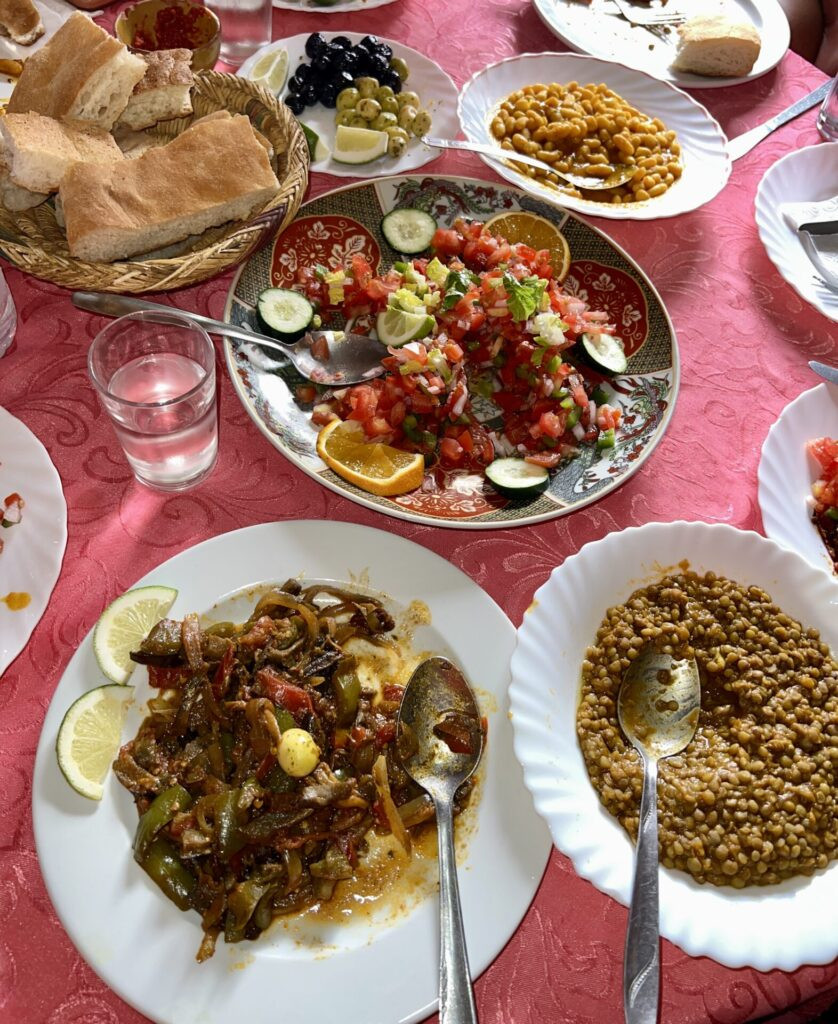 An array of Moroccan food, including beans and various types of bread, showcasing the diverse cuisine
An array of Moroccan food, including beans and various types of bread, showcasing the diverse cuisine
Harira: A hearty soup, typically made with tomatoes, lentils, chickpeas, and lamb. Traditionally served during Ramadan to break the daily fast.
R’fissa: A Casablanca specialty featuring flaky pancakes, chicken in onion broth, herbs, and spices.
Tanjia: A Marrakech-exclusive dish of lamb or veal, slow-cooked in a terracotta jar, resulting in incredibly tender meat.
Tagine: Refers to dishes cooked in a clay pot, often slow-cooked lamb, beef, or chicken with herbs and spices. Tagine was a daily feature of our meals, often chicken or vegetable tagine with couscous. Lemon chicken and beef with prunes were standouts.
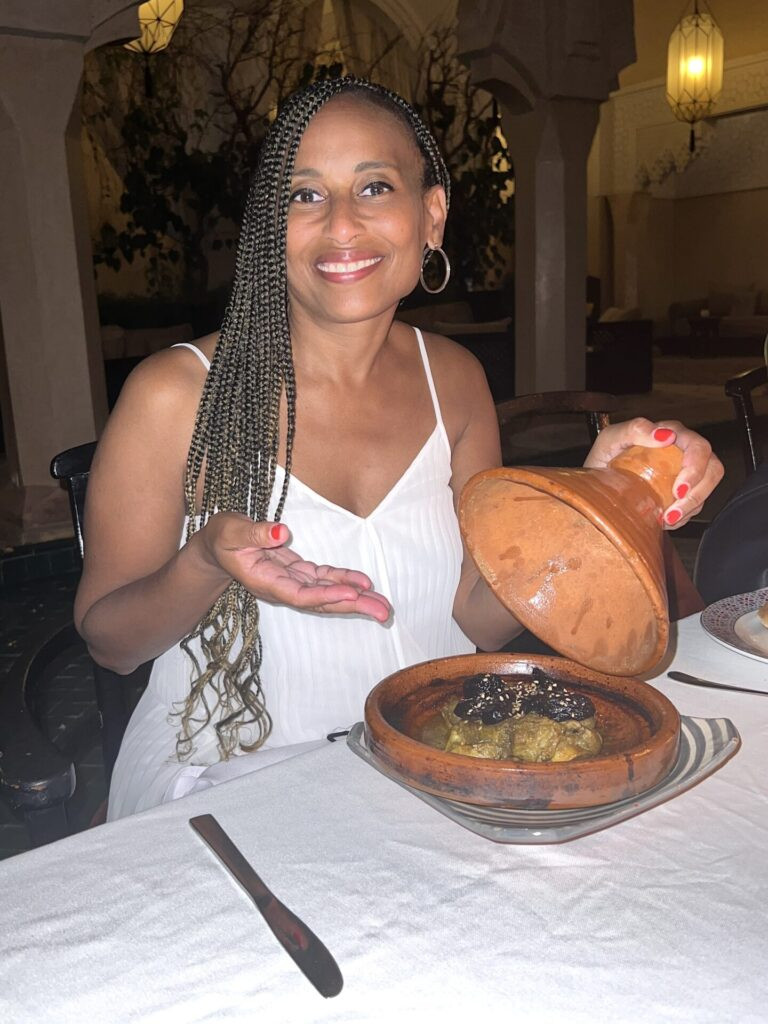 A delicious Tagine meal with beef and prunes, showcasing the traditional Moroccan cooking method
A delicious Tagine meal with beef and prunes, showcasing the traditional Moroccan cooking method
Pastilla (Bastilla): A savory meat pie with poultry or seafood filling. A surprisingly complex dish with sweet notes from sugar, cinnamon, and almonds. Sweet pastry crust, served as appetizer or main course.
Zalouk: A popular side dish spread made from eggplant, garlic, tomatoes, olive oil, and spices, served with crusty bread. Delicious and flavourful!
Gazelle Horns: Moroccan cookies with almond and orange blossom filling, encased in delicate pastry. Perfect with mint tea!
Chebakia: A honey-soaked, fried sesame cookie shaped like a flower. Sticky, sweet, and best enjoyed from market stalls!
Msemen: Similar to pancakes or crepes – flatbread eaten for breakfast or as street food. Can be sweet (with honey and butter) or savoury (stuffed with meat and herbs). Honey is a Moroccan staple; we sampled various types during our Fes food tour!
 A typical Moroccan breakfast spread, featuring pancakes and local delicacies
A typical Moroccan breakfast spread, featuring pancakes and local delicacies
Baghrir: Another Moroccan pancake equivalent, often for breakfast. Known as “thousand hole pancakes” due to the tiny holes formed during cooking.
Mint Tea: The ubiquitous Moroccan beverage. Rooted in ceremonial traditions, it’s now part of daily life. Served hot in glass cups (similar to Turkey). Made with fresh mint and sugar blocks, customisable to your sweetness preference. We learned the preparation process in our cooking class.
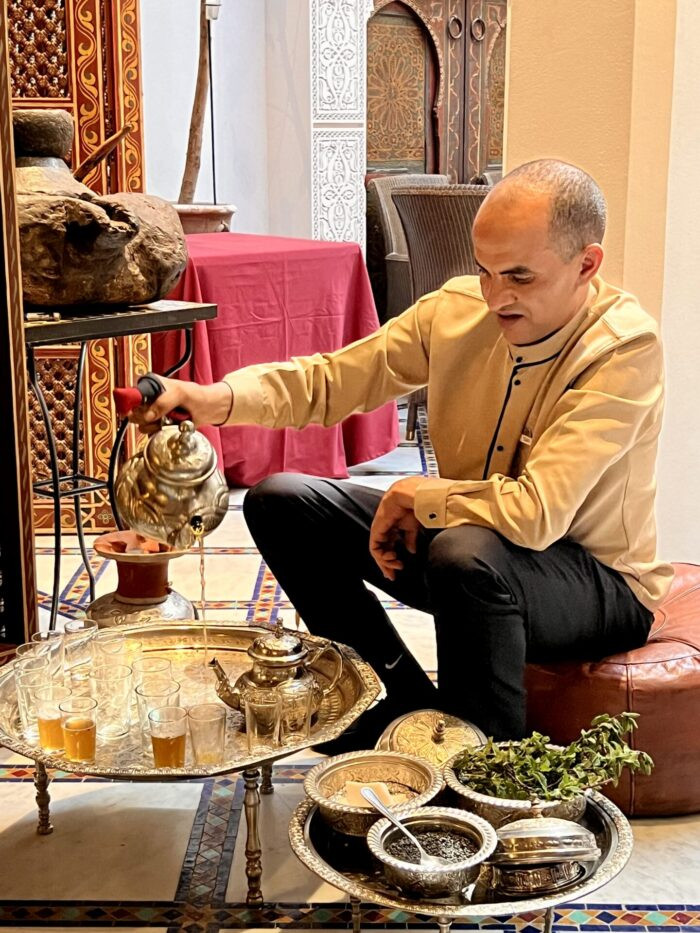 Preparing traditional Moroccan mint tea, demonstrating the pouring technique
Preparing traditional Moroccan mint tea, demonstrating the pouring technique
Don’t forget to explore my other detailed and decadent travel food guides!
Shopping Treasures in Morocco
Morocco is a shopper’s paradise! Had I known the extent of the amazing shopping, I would have packed an extra suitcase! Our group collectively purchased wine, leather goods, home décor, pottery, furniture, mirrors, jewelry, and clothing! Factor shopping into your budget when travelling through Morocco!
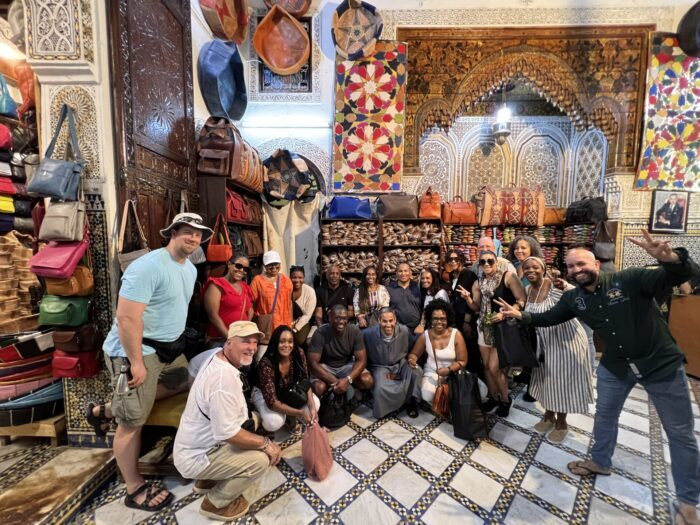 A group browsing leather goods in a Moroccan shop, showcasing the variety of local crafts
A group browsing leather goods in a Moroccan shop, showcasing the variety of local crafts
If you’ve read this far, you deserve a treat! I’m planning another Morocco trip for 2024 or 2025. Join the waiting list to be notified! Stay connected with The Sophisticated Life by subscribing to our newsletter – it’s FREE! Join us on our next Culinary Travels adventure!
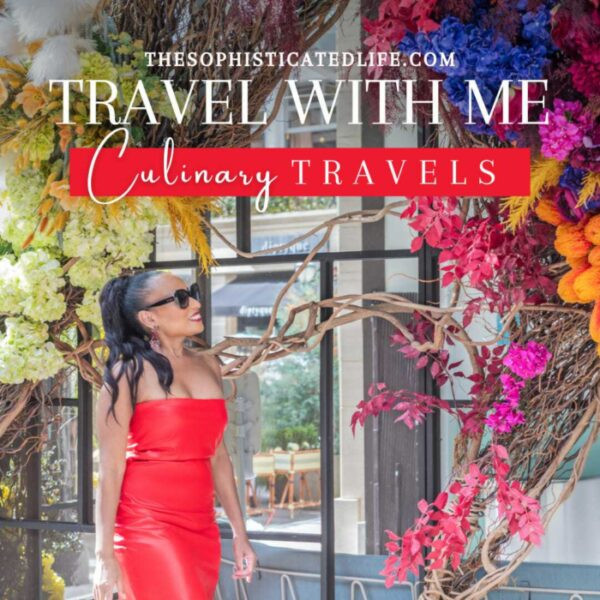 Culinary Travels by The Sophisticated Life
Culinary Travels by The Sophisticated Life
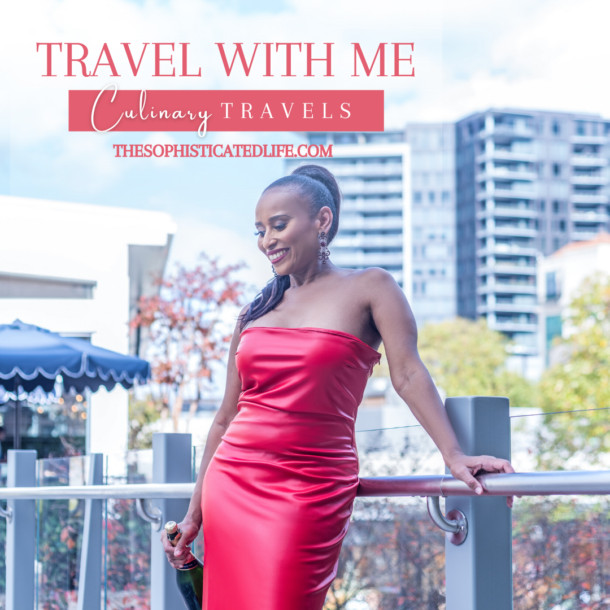 Sign up to learn about luxury travel with food + wine experts all over the world.Sign up to learn about luxury travel with food + wine experts all over the world.
Sign up to learn about luxury travel with food + wine experts all over the world.Sign up to learn about luxury travel with food + wine experts all over the world.
Curated small group trips where all you have to do is pack your bag, relax & enjoy!
+ Receive my free packing & to-do lists for International travel!
Thank you! Check your email for your checklists!
Tags: africamoroccoTraveltravel guides
